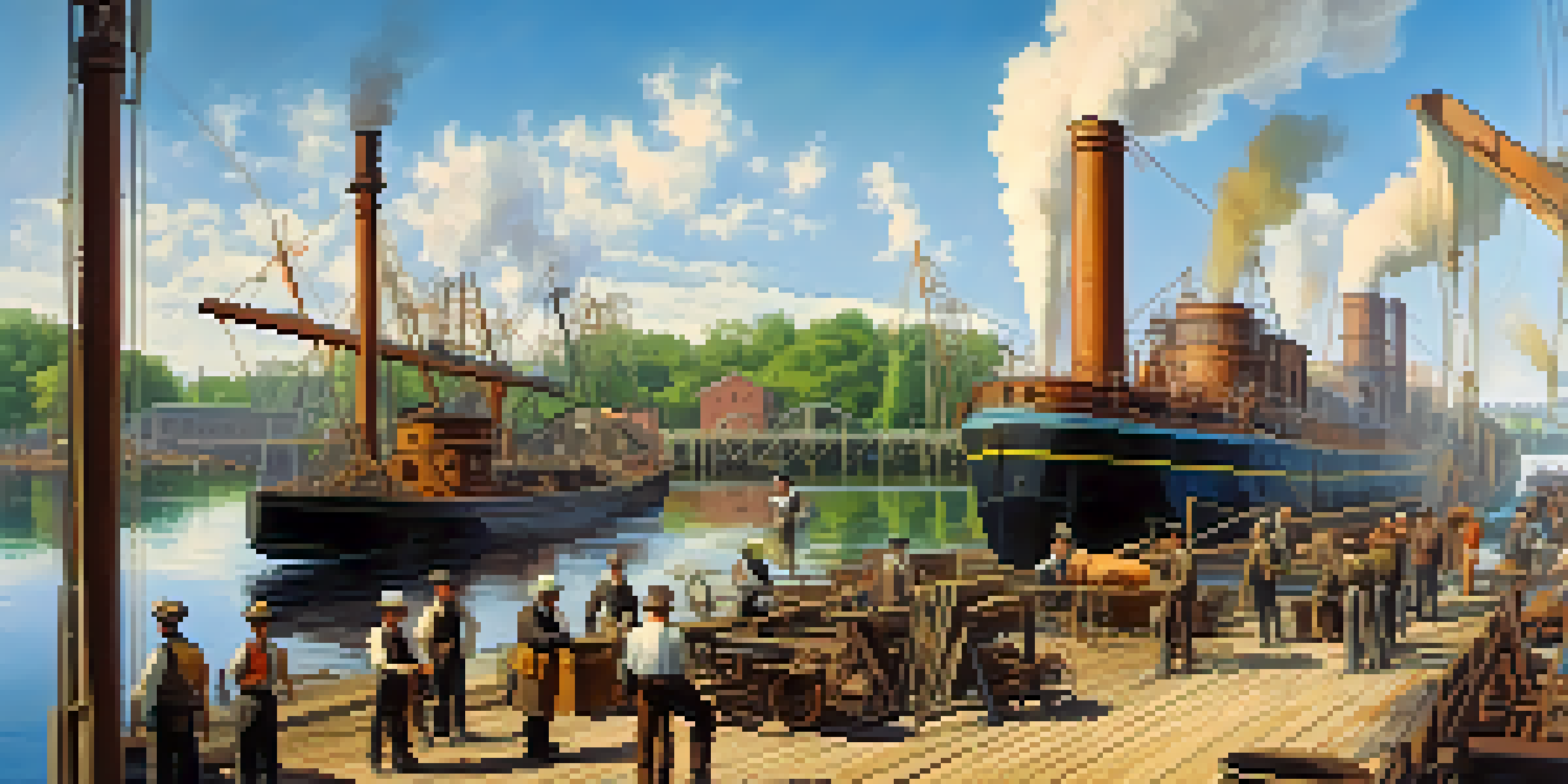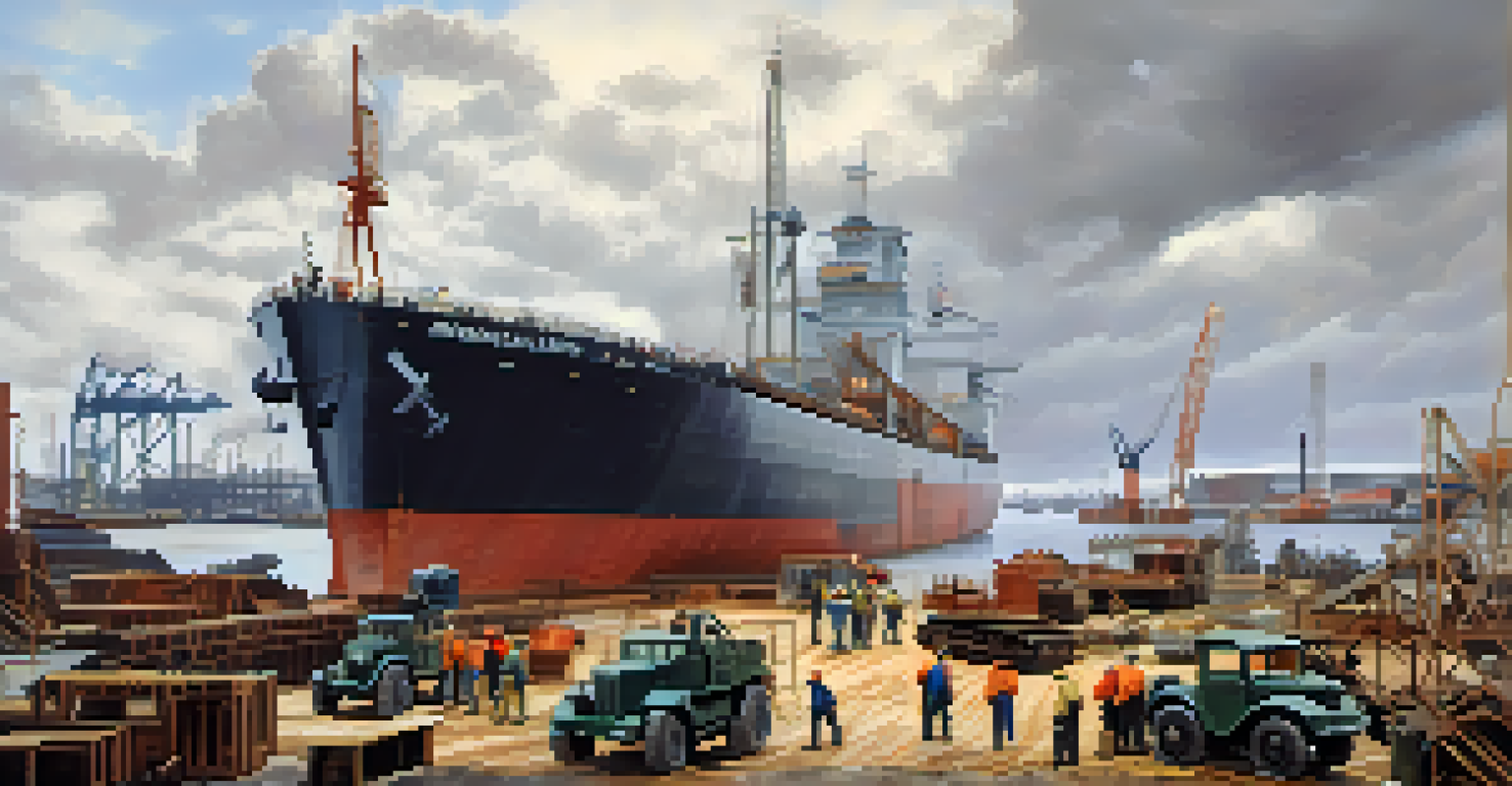The Rise and Fall of Jacksonville's Historic Shipyards

The Birth of Jacksonville's Shipbuilding Industry
In the late 19th century, Jacksonville emerged as a booming hub for shipbuilding, thanks to its strategic location along the St. Johns River. The city's access to the Atlantic Ocean made it an ideal spot for shipyards, attracting businesses and workers alike. With the advent of steam-powered vessels, local shipyards quickly adapted, producing a variety of ships to meet the growing demand.
The greatest glory in living lies not in never falling, but in rising every time we fall.
The shipyards not only stimulated the local economy but also fostered a sense of community among the workers. Families moved to Jacksonville, drawn by job opportunities and the promise of a better life. This period marked the beginning of a vibrant maritime culture that would shape the city's identity for decades to come.
As the industry thrived, Jacksonville became known for its innovative shipbuilding techniques. The combination of skilled labor and a favorable geographic location laid the groundwork for what would become a significant part of American maritime history.
World War II: A Turning Point for Shipyards
World War II brought a surge of demand for military vessels, and Jacksonville's shipyards played a pivotal role in the war effort. The city's facilities were repurposed to build cargo ships and submarines, providing thousands of jobs to local residents. This boom not only solidified the shipbuilding industry but also transformed Jacksonville into a critical player in the national defense strategy.

As the war raged on, the shipyards expanded rapidly, incorporating modern technologies and attracting skilled workers from across the country. The camaraderie among workers fostered a sense of pride as they contributed to something larger than themselves. This period of prosperity marked the peak of the shipbuilding industry in Jacksonville, leaving an indelible mark on the city’s history.
Shipbuilding Thrived Pre-WWII
Jacksonville's strategic location and the advent of steam-powered vessels established it as a significant shipbuilding hub in the late 19th century.
However, with the war's end came a sharp decline in demand for military vessels. Many shipyards that had flourished during the conflict faced the daunting challenge of adapting to a peacetime economy, setting the stage for the industry's eventual decline.
The Post-War Decline and Economic Challenges
In the aftermath of World War II, Jacksonville's shipyards struggled to pivot from military production to civilian shipbuilding. As the demand for new vessels diminished, many companies were forced to downsize or close their doors altogether. This led to significant job losses, and the fabric of the community began to unravel as families were uprooted in search of work.
History is not a burden on the memory but an illumination of the soul.
The economic challenges didn't stop with job losses; the city also faced increased competition from other ports and shipyards across the nation. As advances in technology and globalization changed the landscape of shipbuilding, Jacksonville’s industry found it hard to keep pace. The decline was not just an economic blow; it was a cultural shift that left the city grappling with its identity.
Many shipyard workers, who had once taken pride in their craftsmanship, were left searching for new opportunities. This period marked a turning point in Jacksonville's history, as the shipyards that had once brought prosperity now represented a fading legacy.
Revitalization Efforts and New Beginnings
As the years passed, Jacksonville began to recognize the need for revitalization of its historic shipyards. Community leaders and local businesses came together to explore ways to repurpose these sites for modern use. The goal was to honor the city's maritime heritage while fostering new economic opportunities in the area.
Some shipyard locations were transformed into recreational areas, museums, and mixed-use developments that celebrate the city's maritime history. These initiatives not only preserved the legacy of the shipyards but also attracted tourism and new businesses to the area. The revitalization efforts served as a reminder that while the shipbuilding industry may have declined, its history remained an integral part of Jacksonville's identity.
WWII Boosted Local Shipyards
The demand for military vessels during World War II transformed Jacksonville's shipyards into key players in the national defense, providing numerous jobs and fostering community pride.
The focus on adaptive reuse demonstrated the resilience of the community and its determination to honor its past while looking toward the future. By embracing this blend of history and innovation, Jacksonville began to carve a new path forward.
Cultural Impact of the Shipyards on Jacksonville
The shipyards of Jacksonville were more than just places of work; they were hubs of culture and community. Events, festivals, and gatherings centered around the shipbuilding industry brought residents together, creating a strong sense of identity. These connections forged friendships and shared experiences that would last a lifetime.
As the shipyards declined, the cultural landscape shifted, but the memories remained alive in the hearts of those who had once worked there. Stories of craftsmanship and camaraderie were passed down through generations, ensuring that the legacy of the shipyards would not be forgotten. It became clear that the impact of the shipyards extended far beyond their physical structures.
Today, remnants of the shipbuilding culture can still be seen in Jacksonville's community events and local pride. The spirit of innovation and hard work continues to inspire new generations, proving that while the shipyards may have faded, their influence endures.
Lessons Learned from Jacksonville's Maritime History
The rise and fall of Jacksonville's shipyards offer valuable lessons about resilience and adaptation. Economic shifts can be challenging, but communities that embrace change can find new paths to prosperity. This history serves as a reminder that the ability to pivot and innovate is crucial for survival in an ever-evolving landscape.
Moreover, the story of the shipyards highlights the importance of preserving cultural heritage. By honoring the past, communities can foster a sense of belonging and identity that strengthens their foundations. The efforts to revitalize the shipyards demonstrate how a city can celebrate its history while creating new opportunities for growth.
Revitalization Honors Maritime Past
Efforts to repurpose Jacksonville's historic shipyards into recreational and commercial spaces reflect the city's commitment to preserving its maritime heritage while paving the way for new economic opportunities.
In a world that often prioritizes the new over the old, Jacksonville's experience teaches us to value both. The maritime history of Jacksonville is not just a tale of decline; it is also a story of hope, renewal, and the enduring spirit of a community.
The Future of Jacksonville's Maritime Legacy
Looking ahead, Jacksonville's maritime legacy continues to evolve. With ongoing revitalization projects and a growing interest in maritime education, the city is finding innovative ways to celebrate its shipbuilding history. These initiatives keep the spirit of the shipyards alive while attracting new generations to the maritime industry.
Local organizations and educational institutions are now focusing on training the next generation of skilled workers, ensuring that the knowledge and craftsmanship of the past are not lost. This commitment to education and innovation is vital for maintaining a vibrant maritime industry in the area.

As Jacksonville navigates its future, the lessons learned from its shipyard history will undoubtedly serve as a compass. By balancing respect for the past with a vision for the future, the city can honor its roots while forging a new maritime legacy.